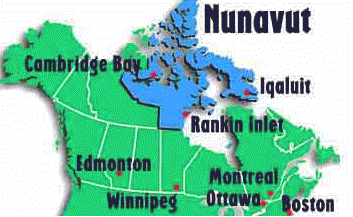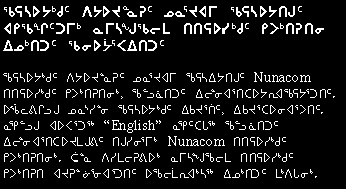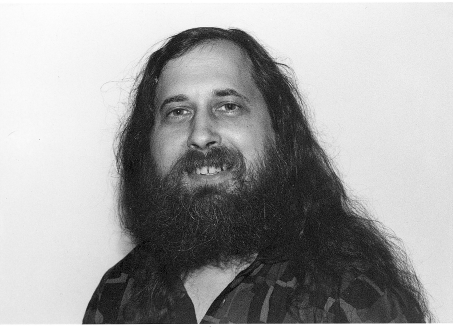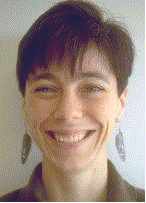

The Conference took place in the large Conference Centre Downtown with about 1000 delegates.
Murray Maloney started the Conference off with an introduction to Canada. On 1 April 1999, Nunavut becomes the first territory to enter the federation of Canada since Newfoundland joined in 1949. Nunavut citizens all have the same rights, but, because the population is about 85 per cent Inuit, it will reflect that reality. The Nunavut Implementation Committee defined the new government structure in a document: Footprints in New Snow.

What has all this got to do with the Web? Well the new territory is fairly dispersed so the Web is the natural focus for news, government, education and living. We recommend a visit to: http://www.nunavut.com.
Inuktitut, the language of the Inuit, is alive and growing. It is widely used throughout the North, and Inuit from across the Arctic can understand one another. Dialects and accents vary from region to region, but Inuktitut is a single language. So there is a need to write the language on the Web pages. Consequently, they are in to Internationalisation in a big way. Here is Inuktitut in Inuktitut:

The Web site is in both English and Inuktitut with a downloadable font available. If the page looks like this, you have completed the download successfully:

Tim Berners-Lee's Opening talk covered some of the ground that he has covered in previous talks with a review of his original dream (access for all, a universal space, a cooperative workspace, independent of culture, language and platform, for use in real life, and machine understandable metadata).
He said that the work over the last few years was getting us there. He particularly pointed out XML Namespaces, RDF, and the new Signed XML with IETF work that is replacing DSig.
Tim raised two main issues. The first was the need for common international standards in digital encryption, authentication etc yet most governments are trying to modify structures set up in the 19th Century to regulate the borderless world of the 21st Century.
The second was the application of patent law particularly in the USA. The bar was miles too low as to what you could patent. People were writing up existing social/mechanical practices and patenting them. Companies were producing sets of interlinked patents that were unintelligible and then using them in contexts that were not always obvious from the original patent application. The ethos of going for anything that you can get away with was creating a trade in fear, uncertainty and doubt. He ended the talk with a request: Dear community, please solve this problem.
This issue of patents had also come up at the Toronto W3C Advisory Committee Meeting. On 19 January 1999, the U.S. Patent and Trademark Office (PTO) issued U.S. patent No 5,862,325 to Intermind. The area of the patent is using metadata to control the exchange of information over the Internet. The patent runs to about 200 pages. There are 126 Claims associated with the patent. There are 47 Figures describing it.
Intermind is currently formulating a progressive licensing program designed to promote the rapid growth of communications object technology.
The problem for W3C is that the Intermind patent threatens open access to W3C's privacy protection technology, the Platform for Privacy Preferences (P3P) and Intermind has indicated that P3P may infringe their patent. W3C has begun researching the validity and applicability of this patent, and is seeking information concerning any software or systems that pre-date the Intermind patent. Fuller details are available on the W3C Web site: http://www.w3.org/1999/05/P3P-PatentPressRelease#you.
An automated communications system operates to transfer data, metadata and methods from a provider computer to a consumer computer through a communications network. The transferred information controls the communications relationship, including responses by the consumer computer, updating of information, and processes for future communications. Information which changes in the provider computer is automatically updated in the consumer computer through the communications system in order to maintain continuity of the relationship. Transfer of metadata and methods permits intelligent processing of information by the consumer computer and combined control by the provider and consumer of the types and content of information subsequently transferred. Object oriented processing is used for storage and transfer of information. The use of metadata and methods further allows for automating may of the actions underlying the communications, including communication acknowledgements and archiving of information. Service objects and partner servers provide specialized data, metadata, and methods to providers and consumers to automate many common communications services and transactions useful to both providers and consumers. A combination of the provider and consumer programs and databases allows for additional functionality, including coordination of multiple users for a single database.
This year's Yuri Rubinsky Award winner was Richard Stallman. Now that it has been running a few years, it was possible to get the previous award winners (Doug Engelbart, Vint Cerf, Gregg Vanderheiden and Ted Nelson) to select this year's winner.
Richard Stallman in 1984 developed the operating system GNU, which was the first major example of free software. Today, Linux-based variants of the GNU system, based on the Linux kernel developed by Linus Torvalds, are in widespread use. There are over 10 million users of GNU/Linux systems today. In 1998 he received the Electronic Frontier Foundation's Pioneer award along with Linus Torvalds.
Stallman's has been advocating for many years that instead of using proprietary software we should use free software that can be interchanged as we wish. It is his pioneering work in this area that gained him the Yuri Rubinsky Award.

Richard Stallman, in accepting the Award, took up Tim's message that something needed to be done about software patents. He pointed out that in June the European Union is planning to legalize software patents in Europe. No study has been done concerning the economic impact of legalising software patents and such a decision would be a major threat to the Web and free software.
The best Paper Award this year was split into two with a prize for the best paper reviewed and a second prize for the best presentation. The two award Winners were:
Best Paper: Focused Crawling: A New Approach for Topic-Specific Resource Discovery by Soumen Chakrabati, Martin van den Berg, Byron Dom.
Given a pre-defined set of topics, the Focused Crawler analyses its crawl boundary to find the links that are likely to be most relevant for its crawl and avoids regions that it thinks are likely to be less productive. The crawler tries to identify hubs (pages with lots of relevant links as these often turn out to be authorities on the topic). Workers explore the crawl boundary and a watchdog keeps them under control. The paper contains a great deal of statistics to back up its claims with regard to relevance and robustness.
Best Presentation: Mary Fernandez, presenting A Query Language for XML by Alin Deutsch, Mary Fernandez, Daniela Florescu, Alon Levy, Dan Suciu.
XML-QL is a query language for extracting data from XML documents. Mary is a researcher at AT&T's Shannon Lab. Her research interests and project's focus on improving software development through the design of very high-level and special-purpose programming languages and the development of tools for their efficient implementation.

The World-Wide Web Conference returns to Europe in the Millennium year. It will take place at the main RAI Conference Centre on the outskirts of Amsterdam. Ivan Herman and Dick Bulterman of CWI, the home of the W3C Netherland's Office, will be organising the Programme.